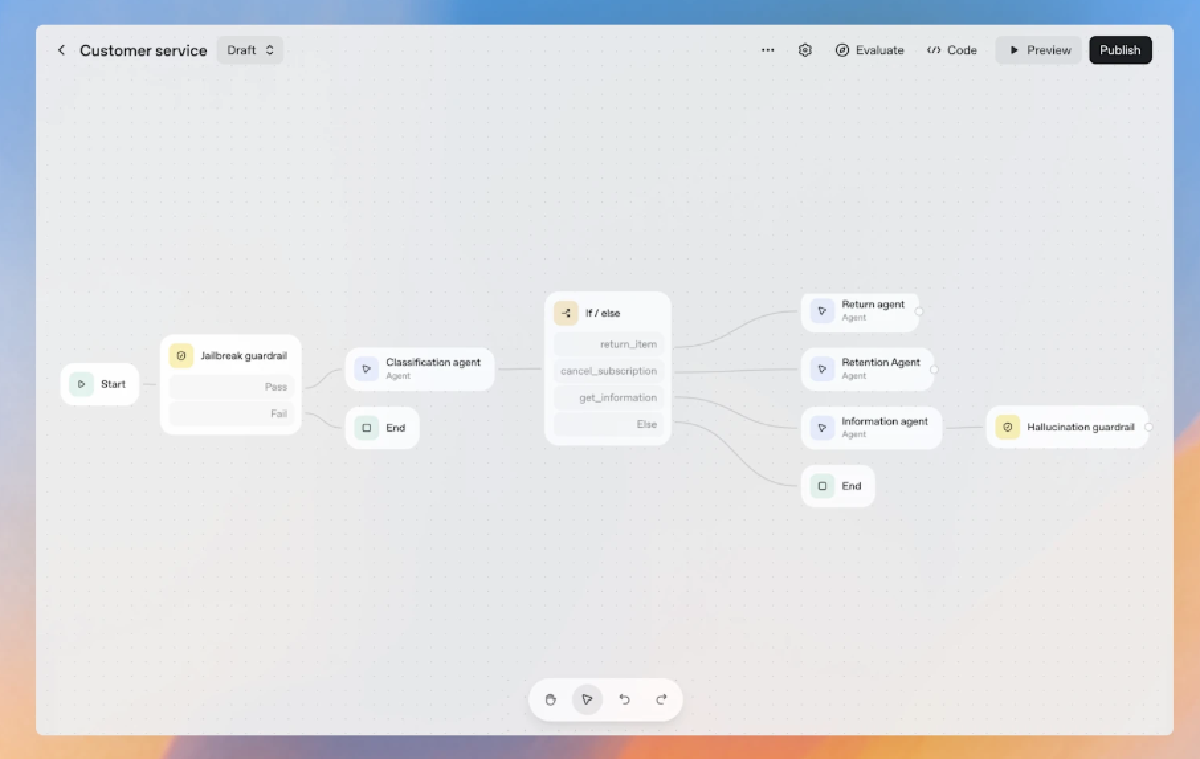OpenAI just launched AgentKit, a comprehensive suite that transforms how developers build, deploy, and optimize AI agents. Instead of cobbling together fragmented tools, developers now have an integrated platform purpose-built for agent development.
What Is AgentKit?#
AgentKit addresses a critical pain point: the complexity of agent development across disconnected tools. It brings together three core components and advanced evaluation capabilities into a unified system.
This isn’t just another developer tool—it’s OpenAI’s answer to the fragmentation challenge that’s been slowing down agent development across the industry.
Agent Builder: Visual Workflow Creation#
The centerpiece of AgentKit is Agent Builder, a visual interface for crafting multi-agent workflows. Instead of writing complex orchestration code, developers can now use drag-and-drop functionality to design how multiple agents work together.
Key capabilities:
- Visual workflow design: Create and manage multi-agent systems through an intuitive interface
- Versioning: Track changes and iterate on agent designs with full version control
- Preview mode: Test agent behaviors before deployment
- Collaboration: Teams can work together on agent workflows in real-time
The visual approach dramatically reduces the time from concept to working prototype. Early adopter Ramp built a buyer agent in just a few hours—a task that previously would have taken significantly longer with traditional code-based approaches.
Connector Registry: Unified Integrations#
The Connector Registry serves as a centralized hub for managing data and tool integrations across OpenAI products. Instead of maintaining separate connections for each agent or workflow, developers get a single source of truth for all integrations.
This consolidation simplifies:
- Managing API connections to external services
- Accessing data sources consistently across agents
- Maintaining authentication and permissions
- Reusing integrations across multiple workflows
The registry approach means when you connect a tool or data source once, it’s available everywhere in your agent ecosystem.
ChatKit: Embeddable Agent Experiences#
ChatKit enables developers to embed customizable chat-based agent experiences directly into their products. This isn’t about building chatbots from scratch—it’s about integrating AI agent capabilities into existing applications with minimal friction.
Developers can customize the interface, control the conversation flow, and maintain their product’s look and feel while leveraging OpenAI’s agent infrastructure underneath.
Enhanced Evaluation Features#
AgentKit introduces comprehensive evaluation capabilities that address a critical gap in agent development: measuring and improving performance systematically.
New features include:
- Datasets: Create and manage test datasets for consistent agent evaluation
- Trace grading: Analyze agent decision-making processes step by step
- Automated prompt optimization: Let the system tune prompts based on performance data
- Third-party model support: Evaluate agents using different models for comparison
These tools enable continuous improvement cycles—developers can identify issues, optimize performance, and validate changes before deployment.
Real-World Impact#
Early adoption data shows significant efficiency gains. Ramp reported a 70% reduction in iteration cycles, accelerating their deployment timelines substantially. What previously took months of development can now be accomplished in hours.
The speed improvement isn’t just about faster development—it enables more experimentation. Teams can test multiple approaches, iterate quickly on feedback, and refine agent behaviors without the traditional overhead of agent development.
The Broader Picture#
AgentKit represents OpenAI’s bet on a future where multi-agent systems are common rather than exceptional. By providing infrastructure that makes agent development accessible, they’re enabling a broader range of developers to build sophisticated AI systems.
The visual interface democratizes agent development beyond specialists, while the evaluation features address enterprise concerns about reliability and performance. Together, these components lower the barrier to production-quality agent deployments.
The timing is strategic. As AI capabilities advance, the bottleneck is shifting from model performance to implementation complexity. AgentKit directly addresses this emerging constraint.
Getting Started#
AgentKit is available now for OpenAI developers. The suite integrates with existing OpenAI APIs and services, so teams already building with OpenAI can adopt AgentKit components incrementally.
For teams just starting with agents, AgentKit provides the full stack needed to go from concept to production—visual design tools, integration infrastructure, evaluation systems, and deployment capabilities in one platform.
Learn more: Check out the official announcement and explore the AgentKit documentation to start building.


